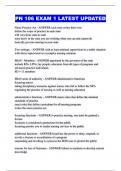Pn 106 pediatric math - Study guides, Class notes & Summaries
Looking for the best study guides, study notes and summaries about Pn 106 pediatric math? On this page you'll find 11 study documents about Pn 106 pediatric math.
All 11 results
Sort by
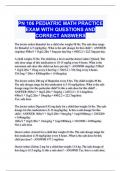
-
PN 106 PEDIATRIC MATH PRACTICE EXAM WITH QUESTIONS AND CORRECT ANSWERS
- Exam (elaborations) • 2 pages • 2024
- Available in package deal
-
- $13.49
- + learn more
PN 106 PEDIATRIC MATH PRACTICE EXAM WITH QUESTIONS AND CORRECT ANSWERS...

-
NCLEX-PN Review (Delmar's Nclex-Pn Review)
- Exam (elaborations) • 722 pages • 2023
-
Available in package deal
-
- $33.84
- 1x sold
- + learn more
Index of Tables xiii Preface xvii Contributors xix CHAPTER 1 HOW TO PREPARE FOR NCLEX-PN® • 1 Questions You Might Have about the Examination 2 What Is the National Council of State Boards of Nursing? 2 What Is the Current Test Plan? 2 How Do I Apply to Take the Examination? 3 What Types of Questions Are on the Examination? 4 Do I Have to Know a Lot About Computers to Take the Examination? 4 How Is the Examination Scored? 4 Can I Take a Break? 4 When Will I Know If I Passed? 4 Tips...
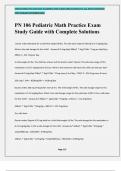
-
PN 106 Pediatric Math Practice Exam Study Guide with Complete Solutions
- Exam (elaborations) • 3 pages • 2024
-
- $9.99
- + learn more
PN 106 Pediatric Math Practice Exam Study Guide with Complete Solutions Doctor orders Benadryl for a child that weighs 98 lbs. The safe dose range for Benadryl is 5 mg/kg/day. What is the safe dosage for this child? - Answer-(mg/day) 98lbs/1 * 1kg/2.2lbs * 5mg per day/1kg = 490/2.2 = 222.7mg per day. A child weighs 52 lbs. The child has a fever and the doctor orders Tylenol. The safe dose range of this medication is 10-15 mg/kg every 6 hours. What is the maximum safe dose this child can ha...
ALL PN106/PN 106 PACKAGED EXAMS !!!!
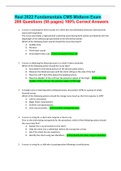
-
Real 2022 Fundamentals CMS Midterm Exam 200 Questions (55 pages) 100% Correct Answers
- Exam (elaborations) • 55 pages • 2022
-
- $15.49
- 2x sold
- + learn more
Real 2022 Fundamentals CMS Midterm Exam 200 Questions (55 pages) 100% Correct Answers 1. A nurse is assessing the heart sounds of a client who has developed chest pain that becomes worse with inspiration. The nurse auscultates a high-pitched scratching sound during both systole and diastole with the diaphragm of the stethoscope positioned at the left sternal border. Which of the following heart sounds should the nurse document? A. Audible Click B. Murmur C. Third heart sound D. Peric...
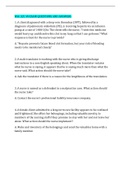
-
NSG 321 V4 EXAM QUESTIONS AND ANSWERS
- Exam (elaborations) • 21 pages • 2023
-
- $16.99
- + learn more
NSG 321 V4 EXAM QUESTIONS AND ANSWERS 1. A client diagnosed with a deep vein thrombus (DVT), followed by a diagnosis of pulmonary embolism (PE), is receiving heparin via an infusion pump at a rate of 1400 U/hr. The client tells the nurse, “I wish this medicine would hurry up and dissolve this clot in my lung so that I can go home.” What response is best for the nurse to provide? A. “Heparin prevents future blood clot formation, but your risk of bleeding needs to be monitored cl...

-
NSG 321 V2 EXAM QUESTIONS AND ANSWERS
- Exam (elaborations) • 23 pages • 2022
-
- $14.49
- + learn more
NSG 321 V2 EXAM QUESTIONS AND ANSWERS 1. A male client with Type 1 diabetes mellitus takes a combination of short-acting and intermediate-acting insulin drugs. The client complains of headaches when awakening and his blood glucose average for the past week has been 210 mg/dl. The nurse recognizes the client is experiencing a daily Somogyi, or rebound, effect. Which dosing method is likely to relieve these symptoms? A. Move the PM intermediate-acting dose to bedtime. 2. When obtaining ...
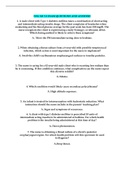
-
NSG 321 V2 EXAM QUESTIONS AND ANSWERS
- Exam (elaborations) • 23 pages • 2022
-
- $14.49
- + learn more
NSG 321 V2 EXAM QUESTIONS AND ANSWERS 1. A male client with Type 1 diabetes mellitus takes a combination of short-acting and intermediate-acting insulin drugs. The client complains of headaches when awakening and his blood glucose average for the past week has been 210 mg/dl. The nurse recognizes the client is experiencing a daily Somogyi, or rebound, effect. Which dosing method is likely to relieve these symptoms? A. Move the PM intermediate-acting dose to bedtime. 2. When obtaining ...
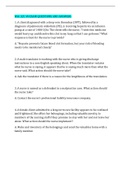
-
NSG 321 V4 EXAM QUESTIONS AND ANSWERS
- Exam (elaborations) • 21 pages • 2022
-
- $14.49
- + learn more
NSG 321 V4 EXAM QUESTIONS AND ANSWERS 1. A client diagnosed with a deep vein thrombus (DVT), followed by a diagnosis of pulmonary embolism (PE), is receiving heparin via an infusion pump at a rate of 1400 U/hr. The client tells the nurse, “I wish this medicine would hurry up and dissolve this clot in my lung so that I can go home.” What response is best for the nurse to provide? A. “Heparin prevents future blood clot formation, but your risk of bleeding needs to be monitored cl...
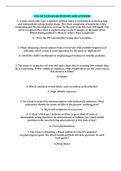
-
NSG 321 V2 EXAM QUESTIONS AND ANSWERS
- Exam (elaborations) • 23 pages • 2023
-
- $17.89
- + learn more
NSG 321 V2 EXAM QUESTIONS AND ANSWERS 1. A male client with Type 1 diabetes mellitus takes a combination of short-acting and intermediate-acting insulin drugs. The client complains of headaches when awakening and his blood glucose average for the past week has been 210 mg/dl. The nurse recognizes the client is experiencing a daily Somogyi, or rebound, effect. Which dosing method is likely to relieve these symptoms? A. Move the PM intermediate-acting dose to bedtime. 2. When obtaining ...

Study stress? For sellers on Stuvia, these are actually golden times. KA-CHING! Earn from your study resources too and start uploading now. Discover all about earning on Stuvia

